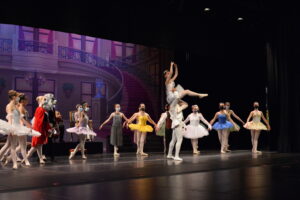 The ballet staff at Cuppett understands the excitement of earning one’s first pair of pointe shoes. Each student’s safety is our first priority and we want our dancers to enjoy the experience. Here is a list of requirements that must be met before a teacher invites you to buy your first pair of pointe shoes.
The ballet staff at Cuppett understands the excitement of earning one’s first pair of pointe shoes. Each student’s safety is our first priority and we want our dancers to enjoy the experience. Here is a list of requirements that must be met before a teacher invites you to buy your first pair of pointe shoes.
- The student must be at least 12 years old. This is a physical development and safety requirement.
- The student must have been consistently taking at least 2 ballet classes a week for at least 2 years. This prepares the student with the strength training and conditioning necessary to be on pointe.
- Must have consistent control of placement (without being reminded): stomach pulled up, tailbone down, ribs closed over hip bones.
- Must consistently have fully stretched arches, with feet fully stretched through tips of the toes.
- Must have high ¾ pointe releve.
- In releve the ankles must be strong and not wobbly.
- Knees must be fully stretched and pulled up.
- Collarbones must be open so that shoulders can be down and back.
- Neck must be long and chin level.
- Must use turn out effectively and consistently.
- Must be able to consistently hold a solid balance in passé releve. It must be clear that the student is in control of the balance and that the student chooses to come out of the balance.
- The student must show that she is serious about ballet by: arriving to class on time with her hair in a classical bun, wearing the correct attire, showing consideration and respect for the instructor and fellow students, and by not talking in or disrupting the class.
- Students must demonstrate correct spotting technique during pirouettes and traveling turns, such as chaines and piques.
- All of the above technique requirements must be ingrained into the student’s movement on a consistent basis.
When a student reaches the level where she is ready for pointe work, the instructor should not have to give reminders of placement; it should be natural for the student. This means that during the course of her ballet training, the student has consistently worked hard to make the corrections given her, and has reached a point where the correct technical demonstration is automatic – it has become a part of the muscle memory and is consistently demonstrated in all movement.
